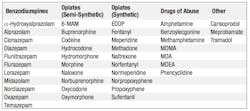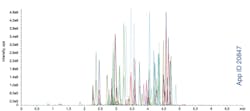Pain management drugs have been on the market for many years and consist of a variety of drug classes including benzodiazepines and opiates (both synthetic and semi-synthetic). In recent years, prescriptions for various pain medications have risen dramatically. For instance, in 2011, the opiate hydrocodone was the most prescribed drug in America.1 Pain clinics, sometimes referred to as “pill mills,” have made it easier to obtain these medications because they are able to both prescribe and fulfill medications. While a good portion of patients who are prescribed these medications have a valid medical reason, it is also very clear that the ease of obtaining such prescriptions has led to increased abuse of these drugs. According to a 2010 study, an estimated 34 million people were reported to have abused pain relievers in their lifetime.2 With so many prescriptions being written for pain medications, the FDA has begun to regulate the number of refills a patient can receive and has also considered changing the classifications of some pain medications to those that are more restrictive.1
Due to the increase in both the use and abuse of pain management drugs, contract clinical and hospital labs are seeing an increase in patient samples that must be screened for a wide variety of these types of drugs. These analyses include screening for compliance and therapeutic drug monitoring as well as for identification of possible drug abuse/misuse. Many of these assays can be very challenging due to the low cut-off levels for certain pain medication panels (often at 20 to 25 ng/mL for compliance testing3) and also due to challenges from potential matrix interferences and even isomeric drug compounds (e.g., isomeric opiate species). In order to be profitable, labs that perform pain panel testing must find a means to rapidly and accurately screen for a variety of drug compounds while keeping costs at a minimum. To address these challenges, many drug testing facilities are increasingly turning to liquid chromatography with tandem mass spectrometry (LC/MS/MS) assays to obtain the necessary sensitivity and specificity for their routine, high-throughput drug screening.
Traditional pain management drug screening techniques
Pain management drug screening was traditionally performed by using an enzyme-linked immunosorbent assay (ELISA). These tests are relatively simple to use, do not require much development time, and can screen for a variety of drug compounds in a single assay.
Although ELISA screens are quick and simple, they are sometimes not available for all drug compounds of interest and cannot quantify the amount of analyte in a patient sample. Instead, a simple positive or negative result is determined based on the cut-off levels of the test. In cases where positive results are detected, confirmation may be done by gas chromatography with mass spectrometry (GC/MS) or LC/MS/MS to determine the concentration of drugs present. Although confirmation tests are performed for positive ELISAs, there is a risk that a false negative may be overlooked. In a study performed by Mikel et al.4 from Millenium Laboratories Research Center, a large percent of positive results for a variety of compounds were not detected by an ELISA and were incorrectly reported as negative (Table 1).
Table 1. False negative results from ELISA4 (data extracted from Mikel et al.)
Urine samples are typically the most popular sample matrix choice because collecting them is not invasive. However, the use of saliva and hair samples has recently gained popularity because they are even easier to procure and reduce the risk of contamination by the patient. These matrices typically display much lower levels of drug compounds compared to urine samples, making the need to test at lower cut-off levels even more important. With the risk of false negatives on ELISAs, it is sometimes necessary to both screen and confirm lower levels using more sensitive techniques such as LC/MS/MS.
New advances in screening and confirmation
Traditionally, chromatography has been used to confirm and quantify the presence of a particular drug after a positive ELISA. GC/MS has been used for many years to provide this confirmation; however, recent advances in high-pressure liquid chromatography/ultra-high-pressure liquid chromatography (HPLC/UHPLC) column technology and ultra-sensitive mass spectrometers have driven a rapid adoption of LC/MS/MS testing in contract and hospital laboratories. Although LC/MS/MS is sensitive and can provide highly accurate results due to the specificity of the mass spectrometer, proper sample preparation is still an important component to ensure reliable test results.
Effective sample preparation
The way in which a sample is prepared can dramatically affect downstream analytical results. If a sample is not properly prepared, target analytes may be lost or diluted, making detection at extremely low levels difficult or impossible. Without adequate sample preparation, matrix components can interfere with accurate identification and quantitation of target molecules. In addition, proper sample preparation techniques can greatly extend the working lifetime of the LC column, which is a vital component in an LC/MS/MS assay, and also reduce system maintenance due to buildup of nonvolatile matrix components.
Solid phase extraction (SPE) has been a popular approach to sample preparation for many reasons. It can be used to specifically isolate and concentrate particular analyte molecules from complex sample matrices using various chemical properties such as hydrophobicity or pKa values. In addition, when properly used, SPE treatment can greatly reduce the levels of potential matrix interferences.
Despite its strengths, SPE can sometimes be a difficult technique to apply when analyzing a large panel of compounds that vary greatly in their chemical nature (e.g., a wide range of target analyte polarities), which is sometimes the case with more extensive pain panel or drug screening assays. Ideally, a single SPE procedure should be used to screen for a wide variety of pain management drugs. The method should result in good recoveries of all target compounds, should require as little time and solvent consumption as possible, and should be automatable for high-throughput laboratories. Recent advances in SPE include specialized sorbents for the extraction of basic drugs of abuse, including pain management drugs. Some of these solutions also allow technicians to skip the condition and equilibration steps that are normally required during an SPE procedure, which provides both time and solvent savings. These savings are multiplied as a laboratory processes more and more samples.
Using a specialized SPE sorbent for the extraction of basic drugs of abuse, a method to extract 41 pain management drugs (Table 2) from a variety of compound classes was developed using urine samples. The method yielded an accuracy of 84% to 120% and precision ranging from 2% to 20% for all 41 drugs monitored. Because the sorbent did not require conditioning or equilibrating, the method saved both time and solvent. The ability to extract all 41 drugs at once also added to time and solvent savings because only one method was necessary to screen the samples for the presence of pain management drugs.
Rapid analytical method
With hundreds or even thousands of patient samples in the queue, contract clinical and hospital labs must perform rapid, yet accurate, analytical methods to detect and quantify pain management drugs. As previously mentioned, LC/MS/MS has grown to become a popular means for analyzing and quantifying pain management drugs because it provides the sensitivity needed to detect down to very low concentration levels within a sample and can also screen for a variety of pain management drugs in a single run. Developing a reliable LC/MS/MS method for analyzing a large panel of pain management drugs requires the use of an HPLC column that can resolve each compound, provide fast run times, and deliver reproducible results. On the instrument side, the mass spectrometer used must provide the sensitivity to accurately detect each compound.
Recent advances in HPLC/UHPLC column technologies include core-shell HPLC/UHPLC columns that contain a durable, homogenous porous shell which is grown on a solid silica core. This technology provides the speed and efficiencies of a smaller particle size without increasing the backpressure. This allows labs to achieve the performance advantages of UHPLC methods on a traditional HPLC without the need to invest in new capital equipment. When analyzing a panel of pain management drugs, the power of core-shell HPLC/UHPLC columns can greatly increase analysis speed, efficiencies, and resolution of target compounds. Using a 2.6-micron core-shell HPLC column, 41 pain management drugs are separated in less than five minutes (Figure 1). Coupled with a sensitive mass spectrometer, target compounds (α-hydroxyalprazolam, for example) are accurately quantified down to low concentration levels (Table 3), making LC/MS/MS a reliable means to screen for and confirm the presence or absence of pain management drugs.
As the use and abuse of pain management drugs increases, contract clinical laboratories and hospital laboratories must find a way to quickly and accurately screen and confirm the presence of a variety of pain management drugs. Traditional techniques such as ELISA are not able to quantitate the amount of drugs present and can produce false negative results. With new advances in sample preparation and LC/MS/MS, laboratories can more accurately screen for a large panel of drug compounds in a single analysis and can accurately quantitate low levels of drug compounds.
References
- FDA panel wants limits on hydrocodone painkillers. USA Today. January 25, 2013.
- National Survey on Drug Use & Health. Substance Abuse and Mental Health Services Administration (SAMHSA). 2010.
- Evans M, Ma’Ayteh B, Constantine J. Therapeutic drug monitoring. Pract Pain Management. 2005;5(5).
- Mikel C, Almazan P, West R, et al. LC-MS/MS extends the range of drug analysis in pain patients. Ther Drug Monit. 2009;31(6):746-748.










